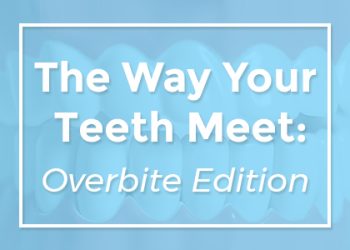The Way Your Teeth Meet: Overbite Edition
 Do you know the status of your occlusion? That’s the technical term used to describe the way your maxillary (upper) and mandibular (lower) teeth align. If you happen to have a bite that doesn’t connect quite right—or at all—it’s referred to as a malocclusion.
Do you know the status of your occlusion? That’s the technical term used to describe the way your maxillary (upper) and mandibular (lower) teeth align. If you happen to have a bite that doesn’t connect quite right—or at all—it’s referred to as a malocclusion.
You might ask yourself, “Well, I can eat and speak without any difficulty, so does the way my teeth touch really matter?” Bellevue dentists, Dr. Mack & Dr. Wachter at Family Dentistry of Bellevue are here to explain why your occlusion is important and focus on the impacts of an overbite. Stay tuned to our blog for discussions on other types of bites, too!
Goldilocks & The Three Bites
When determining whether your bite is properly aligned, the size of your jaws is considered as well as the size of your teeth in proportion to your jaw. With ideal alignment, your teeth should meet at the same time and with equally distributed amounts of pressure. For this to happen, the fine points of your teeth (called cusps) must be arranged like puzzle pieces meant to fit together instead of a corner piece being forced into the middle. It might be a strange visual, but it works when we delve into how an improper bite can cause pain. First, let’s continue discussing the signs of a healthy bite!
It’s normal for the upper jaw to be a little bit larger than your lower jaw, and for your upper set of teeth to overlap your bottom teeth ever so slightly. This harmonious connection permits you to chew food without frequently chomping into your cheeks and tongue, and protects your crowns from excessive wear. So, you want a jaw and bite alignment that isn’t too far forward or too far back, but just right.
I Know the Pieces Fit
Back to the puzzle piece analogy—if your jaws and teeth are disproportionate and don’t fit well together, this incompatibility can cause actions that would otherwise come naturally to take more effort and potentially cause pain. When it comes to overbites specifically, complications can include:
- Increased risk of tooth decay and gum disease
- Excessive wear of your enamel
- Jaw and facial pain
- Headaches and migraines
- Discomfort when speaking or eating
- Sleep apnea
- Altered facial structure
Who knew such a seemingly small abnormality could have such large health consequences? Well, dental health professionals know and want to inform you because these symptoms can get in the way of your quality of life. Luckily, there are ways to correct an overbite, and as technology continues to improve, the methods used to change your bite can be more comfortable, discreet, and economically friendly. Before we discuss those, let’s talk about the potential reasons behind the development of an overbite.
B-B-Bad, Bad to the Bite
What may be the biggest contributor to occlusions and malocclusions is completely out of your control—genetics. However, there are habits formed in childhood that can hinder your bite’s proper formation, such as:
- Tongue Thrusting – This is also called a reverse or immature swallow. Tongue thrusting is an orofacial muscular imbalance marked by a tongue that protrudes through your incisors (front teeth) when you swallow, speak, and while your tongue is at rest. This behavior can indicate a breathing disorder and can push the front teeth and jaw forward.
- Thumb-Sucking & Overuse of Pacifiers & Bottles – These habits can be hard to break because they seem like healthy ways for babies and toddlers to self-soothe and deal with teething, but unfortunately, they can lead to changes in the jaw and teeth that require intervention. As little ones grow, habits like chewing on writing utensils or fingernails can also produce negative effects (especially chipping of the teeth).
- Teeth Grinding – It should come as no surprise that teeth grinding is a habit dentists strongly advise against, but it may be done unconsciously or while you sleep. The pressure of teeth grinding can cause your enamel to weaken and break, creating the need for restorative dental work, as well as inflammation of your TMJ (temporomandibular joint). Mouthguards can help with nighttime teeth grinding and give your TMJ well-deserved rest.
Corrective School for Wayward Bites
In 2015, 4 million people were wearing traditional braces to correct their bites. Treatments like Invisalign® have helped over 7 million people worldwide get their teeth into healthier formation since their use began in 2000. Adults are seeking orthodontic treatment for themselves or their children and teens not only because properly aligned teeth are undeniably beautiful and therefore confidence-boosting, but because the health benefits include an easier oral hygiene routine with happier gums, tooth roots, and jaws.
If you’ve been told you have an overbite, suspect your teeth aren’t meeting right, or are interested in straightening your smile, contact Family Dentistry of Bellevue today! Dr. Mack & Dr. Wachter are always happy to help Bellevue friends and neighbors transform their smiles and experience the difference a healthy bite can make.
The content on this blog is not intended to be a substitute for professional medical advice, diagnosis, or treatment. Always seek the advice of qualified health providers with questions you may have regarding medical conditions.
| Monday | 7:30 AM - 4:30 PM |
| Tuesday | 7:30 AM - 4:30 PM |
| Wednesday | 7:30 AM - 4:30 PM |
| Thursday | 7:00 AM - 2:00 PM |
| Friday | 7:00 AM - 11:00 AM |